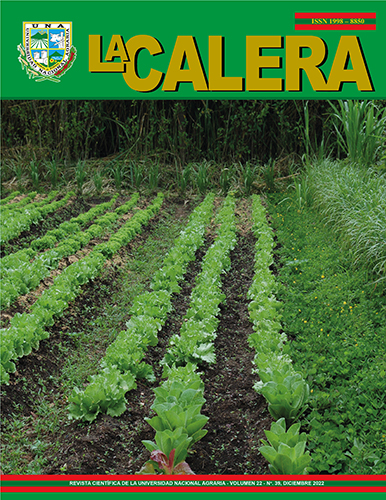Siembra a doble surco y surco sencillo y su efecto en el rendimiento de semilla de frijol común (Phaseolus vulgaris L.)
DOI:
https://doi.org/10.5377/calera.v22i39.15165Palabras clave:
distancias de siembra, parcelas pareadas, producción de semillaResumen
Los sistemas de siembra influyen en la respuesta de los cultivos en el producto final. El objetivo de esta investigación fue determinar la influencia del sistema de siembra a doble surco y la siembra en surco sencillo en el rendimiento de semilla de frijol (Phaseolus vulgaris L.). La investigación se realizó en la época seca en el período de febrero a abril del 2019 en el Centro de Desarrollo Experimental de Frijol La Compañía del Instituto Nicaragüense de Tecnología Agropecuaria, ubicado San Marcos, Carazo, Nicaragua. La Compañía se encuentra a una altura de 470 metros sobre el nivel del mar con temperatura media de 24 °C y precipitación anual entre 1 200 y 1 500 mm. Se utilizó un diseño de parcelas pareadas, comparando la parcela A (doble surco) con la parcela B (surco sencillo). El análisis estadístico fue una prueba de t de Student. El cultivar utilizado fue INTA Rojo Extrema Sequía, generado por el Instituto Nicaragüense de Tecnología Agropecuaria. Los tratamientos fueron dos sistemas de siembra, el primero a doble surco con 80 cm entre calle y 40 cm entre surco, el segundo con surco sencillo a 60 cm entre surco; ambos con 12 semillas por metro lineal. Las variables evaluadas fueron número de vainas por planta, número de granos por vaina y rendimiento en kg ha-1. No se registran diferencias estadísticas en el rendimiento y sus componentes, por lo que se concluye que los componentes del rendimiento y el rendimiento resultan similares indistintamente del sistema de siembra.
Descargas
559
PDF 173
EPUB 111
Publicado
Cómo citar
Número
Sección
Licencia
Derechos de autor 2022 Universidad Nacional Agraria

Esta obra está bajo una licencia internacional Creative Commons Atribución-NoComercial-CompartirIgual 4.0.

